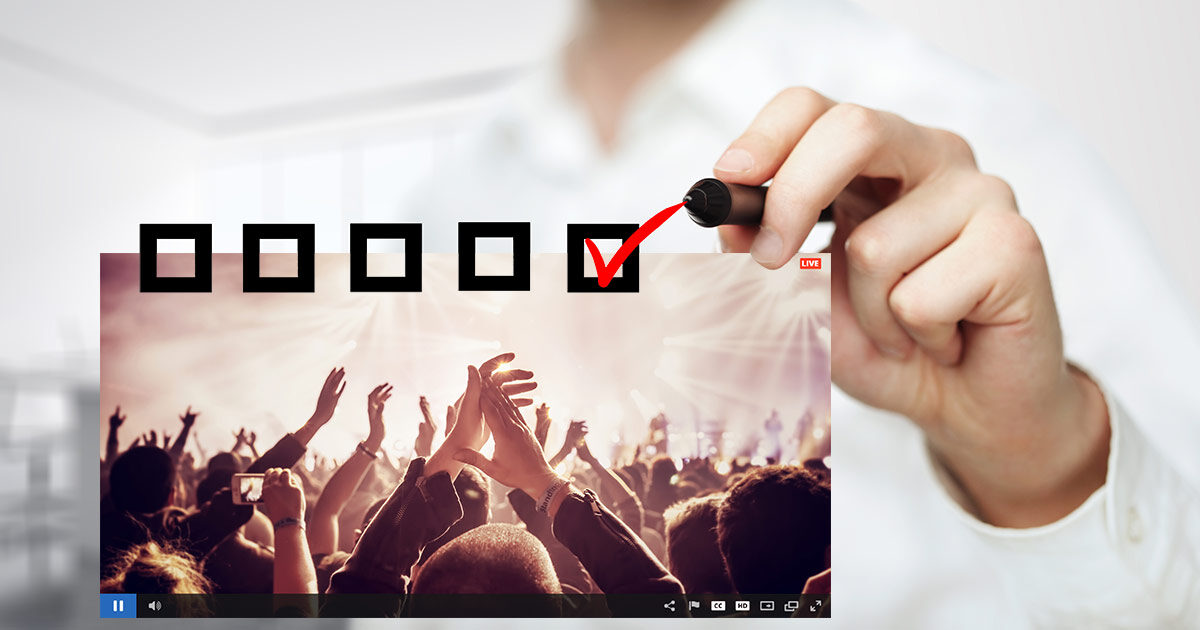
From employee town halls, to product launches, press conferences and ceremonies, virtually all types of events have expanded beyond the physical stage with live streaming. Most events have had two audiences: the one in the room and the one behind their screens. However, some venues are going all virtual. This introduces new opportunities, but also new things to learn.From employee town halls to product launches, press conferences, and ceremonies, virtually all types of events have expanded beyond the physical stage with live streaming. Most events now have two audiences: the one in the room and the one behind their screens. However, some venues are going entirely virtual. This shift introduces new opportunities but also new challenges to address.
For event organizers, the expanded reach of a virtual conference is a dream come true, as are the insights gained from live stream analytics. However, live streaming requires a new level of attention to detail, amplified by the real-time nature of the medium. To ensure live streams proceed smoothly, organizers should follow a high-quality live streaming checklist.
This checklist should include:
- Ensuring a secure and stable internet connection
- Using reliable, tested, and updated equipment
- Defining a clear protocol for the event, including real-time troubleshooting
- Have a back-up connection
- Test all equipment beforehand
- Setup protocol and an emergency plan
Ensuring a secure and stable internet connection
Ensure your streaming location has a dedicated, high-bandwidth internet connection. Test the upload speed and aim for a minimum of 5 Mbps for HD streaming. A dedicated high-speed connection for uploading is a must for any mission-critical live video stream. Keep in mind that a connection which is merely sufficient to check email or load web pages is definitely not good enough for streaming live video.
“One of the most common points of failure is when you share bandwidth with multiple people,” says Jenna Burnett, customer success leader at IBM Video Streaming. “Just like using a cell phone in a heavily congested area, there’s always a chance for inconsistency when you don’t know who else is concurrently on your network.”
In fact, even a 5G cellular network is usually unreliable—and a WiFi network can also be spotty and prone to fluctuation. Having an Ethernet connection is the most reliable way to set up this dedicated line. If there’s no corporate network to use or IT department to contact, users should check with an Internet Service Provider to purchase a plan that has the bandwidth for streaming. A good rule of thumb is for the bitrate of your stream to use no more than 50% of your available upload bandwidth capacity on a dedicated line. For example, if the result you get from a speed test shows that you have 2Mbps of upload speed available, your combined audio and video bitrate should not exceed 1Mbps.
For additional insight, check out our support article on troubleshooting your connection as well as our recommendations for encoder settings.
Using reliable, tested, and updated equipment
You can get quality live streaming results using a variety of encoding products. From free and easy-to-use, to robust and configurable encoders that offer enterprise-grade professional features, you have a lot of options. If possible, use professional-grade cameras, microphones, and encoding devices. Test all equipment prior to the event to avoid technical issues during the live stream. Just be sure to do your research and test your equipment many times ahead of your event. We have several articles to help you evaluate different encoding options for additional information on this topic.
Additionally, by using a virtual encoding software and adding capture cards or boxes, you can turn any Mac or Windows computer into a multi-camera, live-streaming machine. If you’re using the built-in camera on your mobile device or computer, a USB camera, or a dedicated hardware encoder, you won’t need any additional capture device. But if you want to connect analog, HDMI or SDI signals directly to your computer, you’ll need one of these. See more about our recommendations for capture cards and devices.
Defining a clear protocol for the event, including real-time troubleshooting
You’ll want to make sure to use a live monitoring console that gives you the ability to get real time, easy to understand information about your network and your stream while it is live. You’ll want to view performance metrics in real-time to know how your broadcast is performing for your viewers across either ISPs or CDNs. Knowing how many viewers on any given ISP are experiencing buffering during your broadcast, or which ISPs or CDNs currently have the most viewers can be critically important information.
When live streaming, you may run into a variety of issues with connecting your broadcast, or keeping your connection. Checkout these detailed articles to help with troubleshooting in real time.
Have a back-up connection
No connection, no live stream. If something unforeseen happens to your Ethernet connection, it can be helpful to turn to other readily-available options. “There are cameras that can aggregate signals from 4G or 5G modems, so if your line goes down, you should be able to distribute through 4G,” says Jan Ozer, streaming consultant and author of the book Producing Streaming Video for Multiple Screen Delivery.
Redundancy is really important. Have backup equipment and an alternative internet connection available. This includes spare cameras, microphones, and a secondary encoder. For additional detail on backup streaming destinations, see our support article.

Test all equipment beforehand
Newcomers to streaming or video production should stick to familiar equipment that gets the job done. While basic compatibility is important, for example making sure you have an RTMP (real time messaging protocol) based encoder if your platform requires it, another consideration is just making sure the equipment works. This includes weeding out faulty equipment and also understanding if a piece of gear will achieve the needed result.
So be sure to test the equipment beforehand to ensure it works in the needed way. And don’t try to integrate into every other corporate system you have in place out of the gate. Choose one go-to portal destination for viewers and make sure you have an option that works on mobile devices. Other preparation tips are obvious but no less critical: Watch the stream from different devices; test microphones, cameras and other equipment; use a free resource like speedtest.net to check bandwidth.
To get the details right, it’s best to recruit a pro. Video production services can handle the nitty-gritty, from the lighting to encoding. Professionals can also help pull off more complicated streaming scenarios. “Capabilities like multi-camera streaming are where you want someone on the ground who understands how to do it,” says IBM Video Streaming’s Burnett.
Setup protocol and an emergency plan
Being prepared in the event something doesn’t work is often times the best course. One can test their connection and equipment ahead of time, but regardless the unforeseen can happen. If someone accidentally damages a microphone, what’s the course of action to still have a good sounding event? Or what if a viewer calls in saying the stream isn’t working, what’s the protocol to address or validate their concern?
A good checklist item can be to come with a plan in the event something doesn’t work. We touched on this for a backup connection, but backup gear, batteries or power sources can also help. It’s also great to familiarize yourself with what you can do to monitor a stream as well. This can be as simple as having someone watch the broadcast to using more sophisticated trouble shooting tools, like real-time live video monitoring console provided through IBM.
In the event something does seem wrong with the service, it can help to know what your next steps are, and who you contact. Free platforms can sometimes suffer from a lack technical support. When something goes wrong, you’re on your own. Paid services, on the other hand, offer support teams, customization and advanced analytics. In the case of the latter, it’s good to prep contact details in the case something does go wrong so you can work even faster toward a resolution.
Summary
Live event streaming is a major opportunity for companies to make an impression. While the video’s content may be top-notch, a flicker in the live stream screen could impact the audience’s perception of the event. For example, while Facebook Live makes streaming easy, the quality can suffer and there’s no technical support in the event of the inevitable hiccup.
Scalability might also be an issue, being able to deliver to large viewerships. This can be both audiences that are massive in size, or just those with a strong congestion in specific locations. Check with your provider to address your specific needs. Look for those with a strong reputation and check to see if a CDN (Content Delivery Network) is utilized as well. Those that have sophisticated approaches, with built-in fall backs and multi-CDN delivery, will stand out as well. To get started begin an IBM Video Streaming trial or IBM Enterprise Video Streaming trial today!